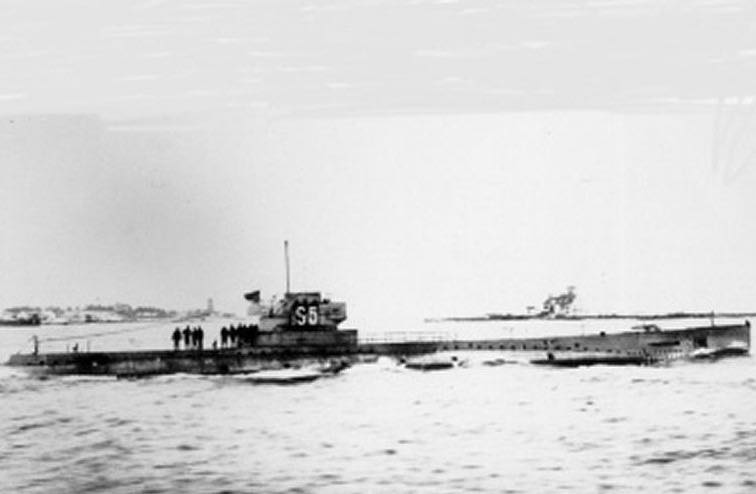
S-5
(SS-110 : dp. 876 (surf.), 1,092 (subm.); 1. 231'; b. 21'10"; dr. 13'1"; s. 15 k. (surf.), 11 k. (subm.);. 38; a. 4 21" tt., 1 4"; cl. S-3)
S-5 (SS-110) was laid down on 4 December 1917 by the Portsmouth ( N.H. ) Navy Yard; launched on 10 November 1919; sponsored by Mrs. Glenn S. Burrell and commissioned on 6 March 1920, Lt. Comdr. Charles M. Cooke, Jr. in command.
Following builder's trials, outfitting, and crew training, S 5 departed Boston Navy Yard on 30 August 1920 to undergo full-power trials off the Delaware Capes. On 1 September, she commenced a dive for a submerged test run. Water unexpectedly entered the submarine through the main air induction system pouring into the control room, engine room, torpedo room, and the motor room.
Normal procedure was to leave the main air induction valve open until the engines had a chance to come to a full stop, this operation being so timed as to occur just prior to complete submergence. In the case of the S-5, however, the man responsible for operating this valve was momentarily distracted. Noticing the mistake, he grabbed the valve lever and jerked hard, causing the valve to jam open.
After considerable difficulty, the system valves in the other compartments were closed, but all efforts to secure the torpedo room valve met with failure. The abandoned torpedo room flooded, making the boat bow heavy. An additional 80 tons of water in the motor room bilges caused her to settle on the bottom.
It was now impossible to eject water from the torpedo room. An attempt was then made to pump out the motor room, but a gasket blew out and there were no means for repair. Lying 194 feet on the bottom, the crew had little hope of being found, much less being rescued.
Their situation now called for some original thinking. They reasoned that sufficient buoyancy in the after section could tilt the sub on her nose and extend the stern above the surface. The tilt would cause the water in the motor room to drain forward and increase buoyancy further. However, there was great risk involved because this would allow salt water into the battery room, which would generate deadly chlorine gas. They hoped to have enough time, after the water had entered, to close the watertight door before the gas could reach a dangerous level.
After making preparations, air was applied to the after ballast and fuel tanks, blowing them dry. The stern began to rise and then shot to the surface. Men floor plates, bilge water, and other loose objects fell through the length of the submarine. One man nearly drowned in the battery room, but was fished out and the compartment door was sealed against the gas.
By tapping on the hull, it was determined that the stern extended about 17 feet above the water. With inadequate tools, they took turns trying to cut a hole in the thick hull. After 36 hours, they had only succeeded in making a hole three inches in diameter.
The steamship Alanthus, however, detected the plight of the submarine. With assistance from the steamship General Goethals, a much larger hole was cut, and the entire crew was rescued.
Later, the battleship Ohio (BB-12) secured a towline to the stern of the S-5 and proceeded to tow her to more shallow water. The towline, however, parted and the loosed sub bobbed, then plunged to the bottom. No attempts were made to salvage S-5, and she was struck from the Navy list in 1921.
